 The QSL of Y83ANT, (sept. 13,1983) shows the GDR station “near Novolazarevskaya” at 71°S, 12°E. There is no mention of a name of this Base on the QSL, just a generic “GDR station near Novolazarevskaya.
The QSL of Y83ANT, (sept. 13,1983) shows the GDR station “near Novolazarevskaya” at 71°S, 12°E. There is no mention of a name of this Base on the QSL, just a generic “GDR station near Novolazarevskaya.
A question arose: If Georg Forster Station was located at 70°46’S-11°51’E, is this old one, the same Base?
We have to thanks 2 Antarctic veterans, several time operating from this Antarctic site, who did help WAP to write a true story of this East Germany (GDR) laboratory, established near the Russian Novolararevskaya Sation: Ing. Andreas Mueller DL3LRM, and Dr. Volker Strecke DL8JDX.
Andreas said:
«Historically, the team from East Germany has been a part of the Russian Novo Station since the late 1970s, but had their own base about a kilometer away from the main building. In 1987, this base (a set of containers and an antenna areal) was named “George Forster” in order to become the first official research station of East Germany, as part of their efforts to be part of the Antarctic Treaty (which demands that a Country has to run a permanent all year base in Antarctica). So this is the reason why the QSL only states “near Novolazarevskaya”, since in 1983, as “George Forster” was not established yet. Had the privilege to visit that site and the plague twice, and also to met some of its residences».
Volker, another old time Antarctic veteran and operator of Georg Forster Station (WAP DDR-Ø1) sent us a complete explanation that clarifies the entire story on the GDR activity in Antarctica.
Volker wrote:
«The former East Germany (German Democratic Republic GDR) acceded to the Antarctic Treaty System (ATS), see http://www.ats.aq on November 19, 1974, initially as non-consultative member. The GDR built this “Container station” in 1976 in the Schirmacher Oasis near the Russian Station Novolazarevskaya (WAP RUS-Ø9). It was called GDR Base Laboratory near Novoalazarevskaya. The only one HAM Radio activity from that Base Laboratory, between 1976 and 1987 was Y83ANT in 1983.
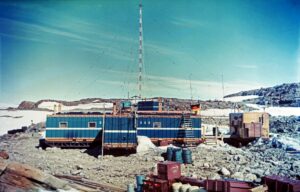 Picture aside, shows an old view, shortly after the completion of the GDR Base Laboratory near Novolazarevskaya in 1976 (Photo: Hartwig Gernandt, AWI Bremerhaven).
Picture aside, shows an old view, shortly after the completion of the GDR Base Laboratory near Novolazarevskaya in 1976 (Photo: Hartwig Gernandt, AWI Bremerhaven).
The GDR research activities included scientific works on ionospherics, magnetics, geology, chemistry and biology, were supported by the Russian colleagues from Novolazarevskaya and by the Indian colleagues from Dakshin Gangotri (WAP IND-Ø1) and Maitri (WAP IND-Ø3).
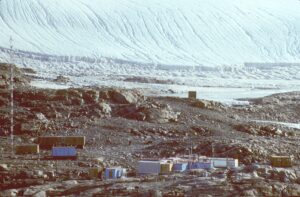 After ratification of the Treaty, the GDR received ATS consultative status on October 5, 1987. This was associated with an own research station in Antarctica. So the existing base laboratory was officially named GDR Antarctic Research Station Georg Forster (WAP DDR-Ø1) at Oct. 25, 1987.
After ratification of the Treaty, the GDR received ATS consultative status on October 5, 1987. This was associated with an own research station in Antarctica. So the existing base laboratory was officially named GDR Antarctic Research Station Georg Forster (WAP DDR-Ø1) at Oct. 25, 1987.
In the summer season 1987-1988 at Georg Forster, a completely new radio station was built. Georg Forster did get the marine Call Y3ZA and the land-based Call Y3G. The radio system was a very powerful and reliable: KSS-1300 with 1 KW, able to operate in CW, SSB and SITOR Telex, several EKD-500 receivers, an extremely good working 2x85m V-Beam, a corner reflector antenna, a diversity antenna, a vertical antenna and several wire antennas».
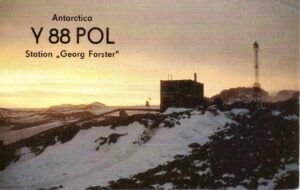 HAM Radio activities from Georg Forster were:
HAM Radio activities from Georg Forster were:
1988-1989 Y88POL (op: DL8JDX)
1989-1991 Y90ANT (op: DK1BT)
1990-1992 Y88POL (op: DL8JDX)

The Georg Forster Base had 5 overwintering teams:
- Antarctic Expedition (AE) 1987-1989 with 8 members (including Volker, DL8JDX, as electronic engineer)
- AE 1988-1990 with 8 members
- AE 1989-1991 with 8 members
- AE 1990-1992 with 4 members (including Volker, DL8JDX, as electronic engineer, Radio officer and Post officer)
- AE 1991-1993 with 1 member
After the German reunification at Oct. 3, 1990 it was decided later that the further German Antarctic research activities would have been focused at Neumayer II Base and its surroundings. So in the years 1994, 1995 and 1996 the entire Georg Forster Station had been dismantled and disposed of.
A commemorative plaque was left at this place. The former Georg Forster base was included into the ATS list of historic sites in Antarctica with No. 87.
List of all Antarctic historic sites: https://documents.ats.aq/recatt/att596_e.pdf
Volker concludes his report saying: «Andreas, DL3LRM is completely right with his comments based on his experience. As he was op. at DPØGVN in Neumaye III and operator at DP0POL/MM on the icebreaker Polarstern, He is the real expert and one of the few persons who were in the Antarctic and in the Arctic in the same year (2020)».
Thanks to Volker, DL8JDX, (WAP Ambassador) and operator in several Antarctic Overwintering Expeditions:
1988-1989 Y88POL Georg Forster
1990-1992 Y88POL Georg Forster
1992-1994 DPØGVN Neumayer II
And thanks to Andreas DL3LRM another great operator for years in Antarctica

Photo 1 aside: Georg Forster base in March 1991 (Photo: Volker Strecke, DL8JDX)
Photo 2 below : Georg Forster Historic Site Plaque in December 2018 (Photo: Andreas Mueller, DL3LRM)
 Photo 3 here at the right: Georg Forster First Day cover with special stamp for the opening of the postal office at May 1, 1988 (Volker Strecke)
Photo 3 here at the right: Georg Forster First Day cover with special stamp for the opening of the postal office at May 1, 1988 (Volker Strecke)
Documents say: The site of the former Georg Forster station is marked by a bronze plaque. It has been designated a Historic Site or Monument (HSM 87), following a proposal by  Germany to the Antarctic Treaty Consultative Meeting.
Germany to the Antarctic Treaty Consultative Meeting.
At the light of this new evidences, a new WAP reference number WAP DDR-Ø2 has been issued to:
GDR Base Laboratory near Novolazarevskaya,
71° South, 12° East
Location: Schirmacher Oasis
Callsign Y83ANT
Year of activity 1983
WAP DDR-Ø1 (from Oct 5, 1987, till Oct. 5, 1990) remains issued for Y88POL and Y90ANT.
The applicants who have submitted Y83ANT as DDR-Ø1, will be automatically credited DDR-Ø2 to it, and they eventually have to submit one of the two calls Y88POL or Y90ANT for DDR-Ø1.
Once again, thanks to DL8JDX and DL3LRM for their evaluable help and support.
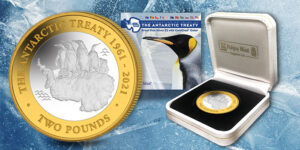 The entry into force of the Antarctic Treaty is recognized as one of the most successful international agreements, setting an example of peaceful cooperation, designated as a “natural reserve, devoted to peace and science”.
The entry into force of the Antarctic Treaty is recognized as one of the most successful international agreements, setting an example of peaceful cooperation, designated as a “natural reserve, devoted to peace and science”.
 Sometimes, as in this case, Arctic and Antarctica are joined together in the bound by the invisible wire of radio waves . That WNP-WAP printed on a very old QSL card intrigues me a lot.
Sometimes, as in this case, Arctic and Antarctica are joined together in the bound by the invisible wire of radio waves . That WNP-WAP printed on a very old QSL card intrigues me a lot. My father would have been 17 years of age at that time and his Ham activity is summarized as follows: The American Radio Relay League Amateur 5AFD 12/7/1925 to 12/31/1926 (his old QSL card on the right), then W5AFD 1/8/1932 to 1/7/1933 and W6KQX6 1/7/1946 to 6/7/1951. Later he was N6AHY»
My father would have been 17 years of age at that time and his Ham activity is summarized as follows: The American Radio Relay League Amateur 5AFD 12/7/1925 to 12/31/1926 (his old QSL card on the right), then W5AFD 1/8/1932 to 1/7/1933 and W6KQX6 1/7/1946 to 6/7/1951. Later he was N6AHY» Arctic Expedition 1925. The card was issued from contact at Etah, Greenland, but based upon the postage stamp it was mailed in Canada.
Arctic Expedition 1925. The card was issued from contact at Etah, Greenland, but based upon the postage stamp it was mailed in Canada.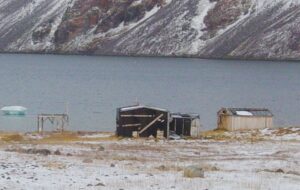
 Well, if we were to go to Antarctica, we’d also find a small image of Don Bosco there too. This photo was taken 15,073 kilometers from Spain as Don Bosco is present as patron of the military contingent that accompanies environmental researchers on the Antarctic Continent.
Well, if we were to go to Antarctica, we’d also find a small image of Don Bosco there too. This photo was taken 15,073 kilometers from Spain as Don Bosco is present as patron of the military contingent that accompanies environmental researchers on the Antarctic Continent.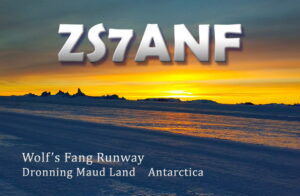 For those who had not yet the luck to work Oleg, ZS7ANF from the Wolf´s Fang Runway, would be useful to know that he is almost every day in the evening hours on 10115 (+/-) in CW.
For those who had not yet the luck to work Oleg, ZS7ANF from the Wolf´s Fang Runway, would be useful to know that he is almost every day in the evening hours on 10115 (+/-) in CW. It is particularly worthy of note that the WhichAway Camp (built in 2010) is in the Schirmacher Oasis at the Lake Podprudnoje at 70° 45′ 49″ South, 11° 36′59″ East,
It is particularly worthy of note that the WhichAway Camp (built in 2010) is in the Schirmacher Oasis at the Lake Podprudnoje at 70° 45′ 49″ South, 11° 36′59″ East, 
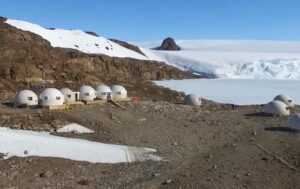
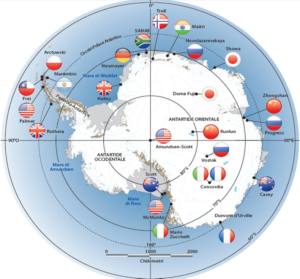 Antarctica
Antarctica 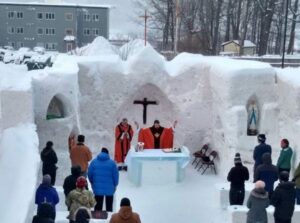 The news reporting the build of an “Ice Chapel” outside St. Albert The Great Parish on Michigan Tech’s campus, (see picture aside) reminds us the Ice chapel carved into the ice at the Argentine Base of Belgrano II (WAP ARG-Ø6) in Antarctica!
The news reporting the build of an “Ice Chapel” outside St. Albert The Great Parish on Michigan Tech’s campus, (see picture aside) reminds us the Ice chapel carved into the ice at the Argentine Base of Belgrano II (WAP ARG-Ø6) in Antarctica!
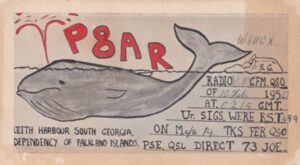 Thanks to Mehdi F5PFP for having shown an old QSL card of VP8AR who did operate from Leith Haurbour in 1950,
Thanks to Mehdi F5PFP for having shown an old QSL card of VP8AR who did operate from Leith Haurbour in 1950,  WAP
WAP  Thanks to Joe De Gasperin I2YDX a keen Dxer and Antarctic Chaser for submitting a rare and old QSL of the
Thanks to Joe De Gasperin I2YDX a keen Dxer and Antarctic Chaser for submitting a rare and old QSL of the  25 years ago, February 6th 1996, Ukraine took over the operation at Base Faraday (or Base F), WAP GBR-Ø7 of the United Kingdom which was sold by the UK for a symbolic one pound. The cost of disassembling the base with good environmental practices and standards would have been too costly.
25 years ago, February 6th 1996, Ukraine took over the operation at Base Faraday (or Base F), WAP GBR-Ø7 of the United Kingdom which was sold by the UK for a symbolic one pound. The cost of disassembling the base with good environmental practices and standards would have been too costly.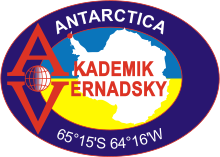
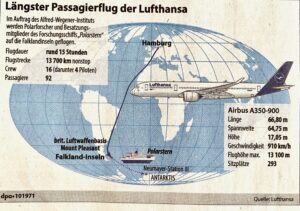 Yesterday, Jan. 31, 2021 another group of German scientists did fly with an Airbus A350-900 directly from Hamburg to Port Stanley, Falklands. There they will be picked up by the Research Icebreaker Polarstern in order to conduct research projects in the Weddel Sea.
Yesterday, Jan. 31, 2021 another group of German scientists did fly with an Airbus A350-900 directly from Hamburg to Port Stanley, Falklands. There they will be picked up by the Research Icebreaker Polarstern in order to conduct research projects in the Weddel Sea.
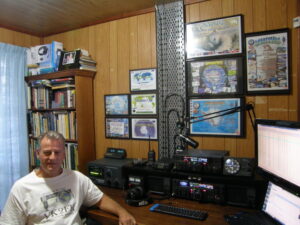


 The QSL of Y83ANT, (sept. 13,1983) shows the GDR station “near Novolazarevskaya” at 71°S, 12°E. There is no mention of a name of this Base on the QSL, just a generic “GDR station near Novolazarevskaya.
The QSL of Y83ANT, (sept. 13,1983) shows the GDR station “near Novolazarevskaya” at 71°S, 12°E. There is no mention of a name of this Base on the QSL, just a generic “GDR station near Novolazarevskaya.
 After ratification of the Treaty, the GDR received ATS consultative status on October 5, 1987. This was associated with an own research station in Antarctica. So the existing base laboratory was officially named GDR Antarctic Research Station Georg Forster (WAP DDR-Ø1) at Oct. 25, 1987.
After ratification of the Treaty, the GDR received ATS consultative status on October 5, 1987. This was associated with an own research station in Antarctica. So the existing base laboratory was officially named GDR Antarctic Research Station Georg Forster (WAP DDR-Ø1) at Oct. 25, 1987.


 Germany to the Antarctic Treaty Consultative Meeting.
Germany to the Antarctic Treaty Consultative Meeting. KM1CC has been “on the air” to commemorate the 118th Anniversary of Marconi sending the first transatlantic message from the USA to Europe (UK) on January 18, 1903. The message was sent from Marconi’s South Wellfleet, MA USA Wireless Station and received at his Poldhu Station, in UK.
KM1CC has been “on the air” to commemorate the 118th Anniversary of Marconi sending the first transatlantic message from the USA to Europe (UK) on January 18, 1903. The message was sent from Marconi’s South Wellfleet, MA USA Wireless Station and received at his Poldhu Station, in UK.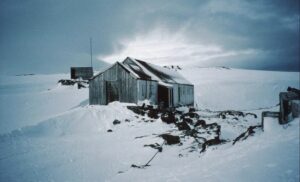 The British established Base W on Detaille Island in 1956, intending to use it to launch dog-sledding expeditions across the ice to the Antarctic Peninsula, and conduct geologic and meteorologic research.
The British established Base W on Detaille Island in 1956, intending to use it to launch dog-sledding expeditions across the ice to the Antarctic Peninsula, and conduct geologic and meteorologic research.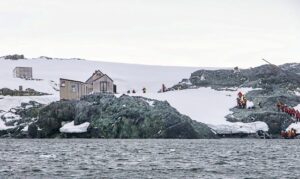
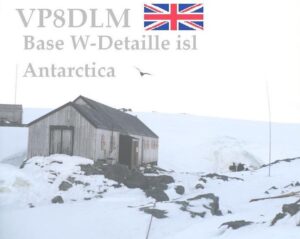 The British Antarctic Survey (BAS) is the national operation running in the frozen desert and is part of the Natural Environmental Research Council. With over 400 staff, BAS takes an active role in Antarctic affairs, operating five research stations, two ships and five aircraft in both polar regions, as well as addressing key global and regional issues. This involves joint research projects with over 40 UK universities and more than 120 national and international collaborations since a small expedition established a permanently occupied base on the continent during World War 2.
The British Antarctic Survey (BAS) is the national operation running in the frozen desert and is part of the Natural Environmental Research Council. With over 400 staff, BAS takes an active role in Antarctic affairs, operating five research stations, two ships and five aircraft in both polar regions, as well as addressing key global and regional issues. This involves joint research projects with over 40 UK universities and more than 120 national and international collaborations since a small expedition established a permanently occupied base on the continent during World War 2. At the end of last november a nontraditional ceremony was held at the Lyttelton Port in Christchurch, New Zealand, to welcome the docking of Chinese research Icebreaker Xuelong 2, or (Snow Dragon 2), which carries members of the 37th Chinese Antarctic scientific expedition, arrived in Christchurch after a 17-day voyage.
At the end of last november a nontraditional ceremony was held at the Lyttelton Port in Christchurch, New Zealand, to welcome the docking of Chinese research Icebreaker Xuelong 2, or (Snow Dragon 2), which carries members of the 37th Chinese Antarctic scientific expedition, arrived in Christchurch after a 17-day voyage.

 WAP-WACA
WAP-WACA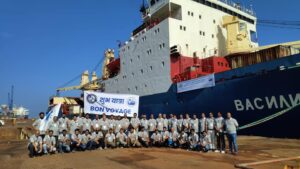 0 ISEA (Indian Scientific Expedition to Antarctica) sailed off from Mormugao Port with 43 Indian members on board.
0 ISEA (Indian Scientific Expedition to Antarctica) sailed off from Mormugao Port with 43 Indian members on board. VE1HQ, Mr. Sheldon Roy Donaldson from Pubnico, NS, Canada, is a keen DXer and Antarctic chaser. He has just received his WAP-WADA Honor Roll plate and certificate on Jan 8th 2021.
VE1HQ, Mr. Sheldon Roy Donaldson from Pubnico, NS, Canada, is a keen DXer and Antarctic chaser. He has just received his WAP-WADA Honor Roll plate and certificate on Jan 8th 2021.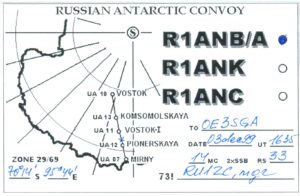 Often, studies were carried out on the scientific traverse as for example the 1978–1984 Mirny–Komsomolskaya–Ridge B, Denman Glacier and Dome Concordia, or the 1999-2000 Mirny-Vostok traverse with intermediate stops at Pionerskaya (WAP RUS-1Ø), and Konsomolskaya (WAP RUS-Ø5) as well as the so called Vostok I (WAP RUS-14) and more specifically the stopping sites on the way to the North and South of Vostok I Base as reported on several QSL cards.
Often, studies were carried out on the scientific traverse as for example the 1978–1984 Mirny–Komsomolskaya–Ridge B, Denman Glacier and Dome Concordia, or the 1999-2000 Mirny-Vostok traverse with intermediate stops at Pionerskaya (WAP RUS-1Ø), and Konsomolskaya (WAP RUS-Ø5) as well as the so called Vostok I (WAP RUS-14) and more specifically the stopping sites on the way to the North and South of Vostok I Base as reported on several QSL cards.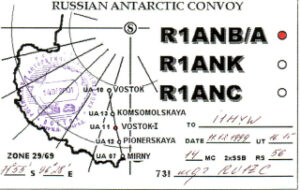 So for example: Ham radio did operate from there so for example R1ANB/A at 70° 14’ South-95° 44’ East (3 dec.1999), 71° 55’ Sout-96° 28’ East (11.dec.1999), 75° 12’ South-97°02’ East (14 dec.1999), R1ANC did operate at 69° 24’ South-95° 11’ East (27 dec.1999), where most of the ground Radio Echo Soundings inspections have been done.
So for example: Ham radio did operate from there so for example R1ANB/A at 70° 14’ South-95° 44’ East (3 dec.1999), 71° 55’ Sout-96° 28’ East (11.dec.1999), 75° 12’ South-97°02’ East (14 dec.1999), R1ANC did operate at 69° 24’ South-95° 11’ East (27 dec.1999), where most of the ground Radio Echo Soundings inspections have been done.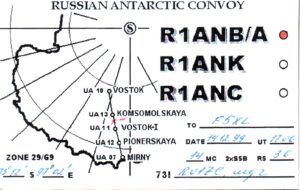 From 25 dec.2002 through 15 jan.2003, on the 48th Russian Antarctic Expedition (RAE) R1ANC/P did operate at 78°18’ South, 106°32’ East as well reported by the operator (UA1PAC Alex Kuz’menko) itself:
From 25 dec.2002 through 15 jan.2003, on the 48th Russian Antarctic Expedition (RAE) R1ANC/P did operate at 78°18’ South, 106°32’ East as well reported by the operator (UA1PAC Alex Kuz’menko) itself: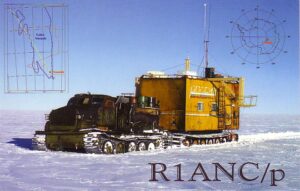 Antarctica.
Antarctica. 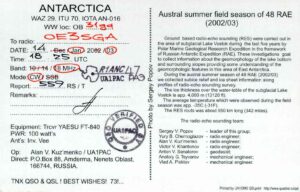 During the austral summer season of 48 RAE (2002/03) we collected sub-ice relief and ice sheet information along profiles of radio-echo sounding survey. The ice thickness over the water-table of the subglacial Lake Vostok is app. 4,000 m (13120 ft). The average temperature which’ were observed during the field season was app. -35C (-31F). The RES routs was about 550 km long (342 miles).
During the austral summer season of 48 RAE (2002/03) we collected sub-ice relief and ice sheet information along profiles of radio-echo sounding survey. The ice thickness over the water-table of the subglacial Lake Vostok is app. 4,000 m (13120 ft). The average temperature which’ were observed during the field season was app. -35C (-31F). The RES routs was about 550 km long (342 miles).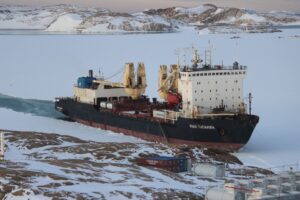 The chartered ice-class vessel M/V Vasiliy Golovnin will make this journey and will reach Antarctica in 30 days.
The chartered ice-class vessel M/V Vasiliy Golovnin will make this journey and will reach Antarctica in 30 days.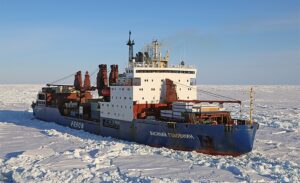
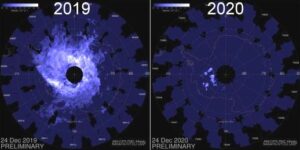
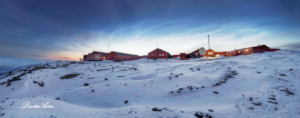
 Dear friends, followers and Antarctic chasers,
Dear friends, followers and Antarctic chasers,
 This marks the start of a month-long “Sea Trials Phase” and an important milestone for all involved in the icebreaker project across the Australian Antarctic Division, ship managers Serco and ship builders Damen.
This marks the start of a month-long “Sea Trials Phase” and an important milestone for all involved in the icebreaker project across the Australian Antarctic Division, ship managers Serco and ship builders Damen.
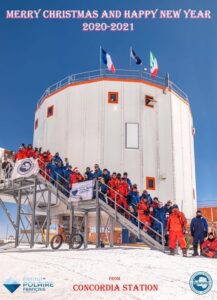
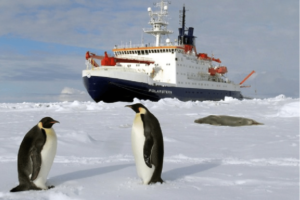 On Tuesday Dec. 22, the German Research Icebreaker Polarstern left the port of Bremerhaven. On board YL Theresa DC1TH and Felix DL5XL. They are now on the way direct down to Antarctica. DPØPOL/MM has already been reported QRV on 20 mts CW.
On Tuesday Dec. 22, the German Research Icebreaker Polarstern left the port of Bremerhaven. On board YL Theresa DC1TH and Felix DL5XL. They are now on the way direct down to Antarctica. DPØPOL/MM has already been reported QRV on 20 mts CW. 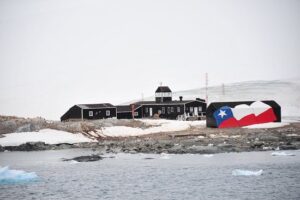 PCR swab tests given to Chilean researchers at the General Bernardo O’Higgins Riquelme (pic aside) came back positive.
PCR swab tests given to Chilean researchers at the General Bernardo O’Higgins Riquelme (pic aside) came back positive.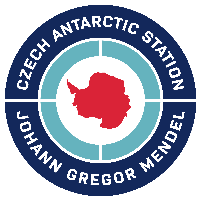 Despite the current situation, the Czech Antarctic Research Program will continue with field research. An eight-member team has departed from Prague on Wednesday, December 16th to Chile, where they will quarantine at a hotel, before heading on to
Despite the current situation, the Czech Antarctic Research Program will continue with field research. An eight-member team has departed from Prague on Wednesday, December 16th to Chile, where they will quarantine at a hotel, before heading on to  The expedition will be led by climatologist and polar explorer Kamil Láska from the Department of Geography, at Masaryk University’s Faculty of Science. The operation of the station will be overseen by technicians from Czechoslovak Ocean Shipping, František Vorel and Tomáš Spáčil.
The expedition will be led by climatologist and polar explorer Kamil Láska from the Department of Geography, at Masaryk University’s Faculty of Science. The operation of the station will be overseen by technicians from Czechoslovak Ocean Shipping, František Vorel and Tomáš Spáčil. The vessel, known as ‘Orange Roughy’, completed its last trip among the long list of its scientific expeditions for the Australian Antarctic Division on Dec 12.
The vessel, known as ‘Orange Roughy’, completed its last trip among the long list of its scientific expeditions for the Australian Antarctic Division on Dec 12.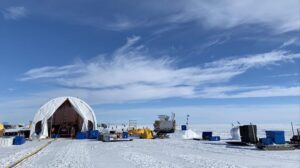 Located at 82°00’ South, 155° 00’ West, Siple Coast is the middle portion of the relatively ill-defined coast along the East side of the Ross Ice Shelf. Siple Coast is the grounding line of the West Antarctic Ice Sheet, where the ice meets the ocean and starts to float, becoming the Ross Ice Shelf. It is as far south as the ocean reaches anywhere in the world.
Located at 82°00’ South, 155° 00’ West, Siple Coast is the middle portion of the relatively ill-defined coast along the East side of the Ross Ice Shelf. Siple Coast is the grounding line of the West Antarctic Ice Sheet, where the ice meets the ocean and starts to float, becoming the Ross Ice Shelf. It is as far south as the ocean reaches anywhere in the world.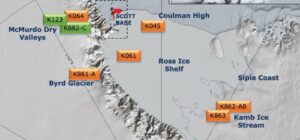 (See location 862AB on the map) This season’s main objective is to develop an understanding of the nature of the sea-floor sediments. Future retrieval of deep sediment cores will help inform multidisciplinary studies of the stability of the Ross Ice Shelf during past warm periods. Drill holes at the Siple Coat will also support the United States Icefin project. Icefin is an under-ice robot designed to explore ice-ocean environments here on Earth and ultimately on Jupiter’s icy moon named Europa.
(See location 862AB on the map) This season’s main objective is to develop an understanding of the nature of the sea-floor sediments. Future retrieval of deep sediment cores will help inform multidisciplinary studies of the stability of the Ross Ice Shelf during past warm periods. Drill holes at the Siple Coat will also support the United States Icefin project. Icefin is an under-ice robot designed to explore ice-ocean environments here on Earth and ultimately on Jupiter’s icy moon named Europa. Station N (1) Bay of Isles
Station N (1) Bay of Isles  On Anvers Island, the British Antarctic Survey built and operated a Station (Base N “2”) Anvers Island at Arthur Harbour, 64°46’ South, 64°05’ West, with purpose of survey and geology. (Pic aside show the Base as it was in 1955)
On Anvers Island, the British Antarctic Survey built and operated a Station (Base N “2”) Anvers Island at Arthur Harbour, 64°46’ South, 64°05’ West, with purpose of survey and geology. (Pic aside show the Base as it was in 1955) The Hut at Station (Base N “2”) was loaned to the U.S. Government on July 2, 1963, which converted it into a biological laboratory and added a new building (the red one on the pic aside) in January 1965 for use by American scientists at the nearby Palmer Station.
The Hut at Station (Base N “2”) was loaned to the U.S. Government on July 2, 1963, which converted it into a biological laboratory and added a new building (the red one on the pic aside) in January 1965 for use by American scientists at the nearby Palmer Station. The actual facility (WAP USA-23) at 64°46’27” South, 64°03’10” West is practically the second Palmer Station and it’s located on Anvers Island (pic to the left).
The actual facility (WAP USA-23) at 64°46’27” South, 64°03’10” West is practically the second Palmer Station and it’s located on Anvers Island (pic to the left). WAP USA-33, “Old Palmer” (Pic to the right) served as a base for those building “New Palmer”, which opened in 1968. Old Palmer was designated as an emergency refuge for the new station in case of disaster, though this perceived need disappeared over time. It was dismantled and removed from the Antarctic as part of the National Science Foundation’s environmental cleanup efforts in the early 1990s. According to Mehdi F5PFP, Old Palmer Station at Arthur Harbour was active on air by KC4AAC 1963 & KC4USP 1965 .
WAP USA-33, “Old Palmer” (Pic to the right) served as a base for those building “New Palmer”, which opened in 1968. Old Palmer was designated as an emergency refuge for the new station in case of disaster, though this perceived need disappeared over time. It was dismantled and removed from the Antarctic as part of the National Science Foundation’s environmental cleanup efforts in the early 1990s. According to Mehdi F5PFP, Old Palmer Station at Arthur Harbour was active on air by KC4AAC 1963 & KC4USP 1965 . Station N (2) was re-open by the British in support of air facility 1969-1971 (pic to the left).
Station N (2) was re-open by the British in support of air facility 1969-1971 (pic to the left).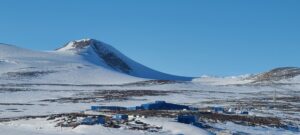 WAP
WAP Lee sent us some pics which we are happy to share with the readers. After stopping by at Jangbogo Station (WAP KOR-Ø2) Lee is expect to reach King Sejong Base (WAP KOR-Ø1)at beginning of January for a long stay.
Lee sent us some pics which we are happy to share with the readers. After stopping by at Jangbogo Station (WAP KOR-Ø2) Lee is expect to reach King Sejong Base (WAP KOR-Ø1)at beginning of January for a long stay.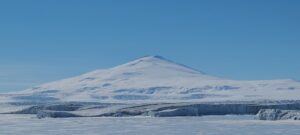
 The ice-breaking research vessel Araon was built in 2009 and is sailing under the flag of Korea. She did explore the South and North Pole regions on several missions since 2009 as part of global efforts to examine the cause of global warming and study the Arctic & Antarctic ecosystem.
The ice-breaking research vessel Araon was built in 2009 and is sailing under the flag of Korea. She did explore the South and North Pole regions on several missions since 2009 as part of global efforts to examine the cause of global warming and study the Arctic & Antarctic ecosystem.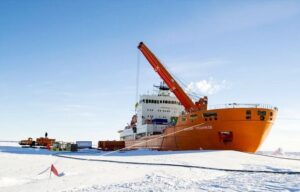 Icebreaker AKADEMIK TRYOSHNIKOV (IMO 9548536, MMSI 273359440, Callsign UBXH3) was reported two days ago by MarinecTraffic Terrestrial Automatic Identification System as sailing in the Atlantic Ocean.
Icebreaker AKADEMIK TRYOSHNIKOV (IMO 9548536, MMSI 273359440, Callsign UBXH3) was reported two days ago by MarinecTraffic Terrestrial Automatic Identification System as sailing in the Atlantic Ocean.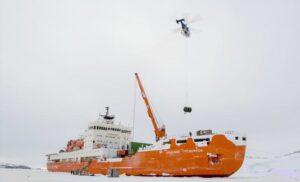

 As part of the seasonal work of
As part of the seasonal work of 
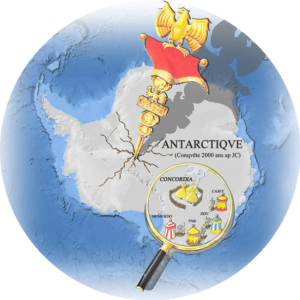 Antarctica has been called “the continent without language”. True languages are spoken only by human beings, and although there are many visiting scientists and support workers in Antarctica these days, this is a modern situation: the continent has never had indigenous languages because it has never had an indigenous human population.
Antarctica has been called “the continent without language”. True languages are spoken only by human beings, and although there are many visiting scientists and support workers in Antarctica these days, this is a modern situation: the continent has never had indigenous languages because it has never had an indigenous human population. Organizing an Antarctic expedition in the times of COVID19 is quite a challenge, so the German Polar Institute (AWI) had to find a different approach to the logistics for the upcoming Antarctic summer season. All transports will be carried out by ship directly from Germany. There is only a small team of about 20 technicians and scientists travelling to Neumayer III Station (WAP DEU-Ø8), this year. YL Theresa, DC1TH and Felix, DL5XL will be part of that group.
Organizing an Antarctic expedition in the times of COVID19 is quite a challenge, so the German Polar Institute (AWI) had to find a different approach to the logistics for the upcoming Antarctic summer season. All transports will be carried out by ship directly from Germany. There is only a small team of about 20 technicians and scientists travelling to Neumayer III Station (WAP DEU-Ø8), this year. YL Theresa, DC1TH and Felix, DL5XL will be part of that group.
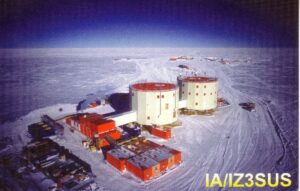 While the French Minister of Research greets the new coming personnel involved in the new Antarctic season at the French-Italian Station, the winter-over did end at Concordia (WAP MNB-Ø3) with the arrival of the first flight from MZS (WAP ITA-Ø1).
While the French Minister of Research greets the new coming personnel involved in the new Antarctic season at the French-Italian Station, the winter-over did end at Concordia (WAP MNB-Ø3) with the arrival of the first flight from MZS (WAP ITA-Ø1).
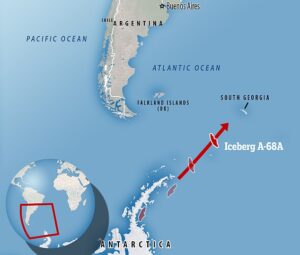 Over the last three years, satellite missions such as Copernicus Sentinel-1 have been used to track the berg as it has drifted in the Southern Ocean. For the first two years, it remained close to its parent ice sheet, impeded by sea ice. But now, as the map shows, the main chunk of the A-68 berg, known as A-68A, is heading rapidly for South Georgia. It is now about 350 km from the island.
Over the last three years, satellite missions such as Copernicus Sentinel-1 have been used to track the berg as it has drifted in the Southern Ocean. For the first two years, it remained close to its parent ice sheet, impeded by sea ice. But now, as the map shows, the main chunk of the A-68 berg, known as A-68A, is heading rapidly for South Georgia. It is now about 350 km from the island.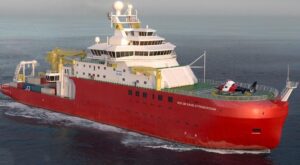 Sir David Attenborough (IMO: 9798222, Callsign ZDLQ3 ) is a Research Vessel registered and sailing under the flag of Falkland Islands. Her gross tonnage is 15000 and deadweight is 5000. Sir David Attenborough was built in 2018/2020.. Her container capacity is 0 TEU. The ship is operated by British Antarctic Survey .
Sir David Attenborough (IMO: 9798222, Callsign ZDLQ3 ) is a Research Vessel registered and sailing under the flag of Falkland Islands. Her gross tonnage is 15000 and deadweight is 5000. Sir David Attenborough was built in 2018/2020.. Her container capacity is 0 TEU. The ship is operated by British Antarctic Survey .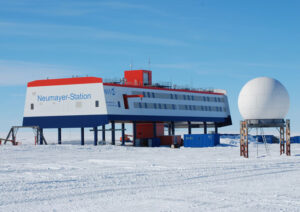 Southgate Amateur Radio News reports that, on November 3, 2020, German TV broadcaster WDR aired a news story about radio amateur Theresa DC1TH who is part of the Neumayer-III Base 2021/22 overwintering crew.
Southgate Amateur Radio News reports that, on November 3, 2020, German TV broadcaster WDR aired a news story about radio amateur Theresa DC1TH who is part of the Neumayer-III Base 2021/22 overwintering crew.  On November 6th, Chile has celebrated the “Chilean Antarctic Day”. WAP join the event and share it with all the women and all the men who love Antarctica and dream of the White Continent.
On November 6th, Chile has celebrated the “Chilean Antarctic Day”. WAP join the event and share it with all the women and all the men who love Antarctica and dream of the White Continent.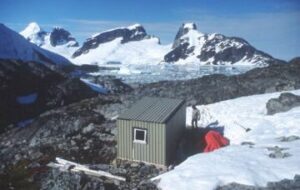 Also known as Rasmussen Point, this Hut is located at 65°15’South, 64°06’West on Rasmussen Island in the North part of Waddington Bay, Graham Coast in Antarctica.
Also known as Rasmussen Point, this Hut is located at 65°15’South, 64°06’West on Rasmussen Island in the North part of Waddington Bay, Graham Coast in Antarctica.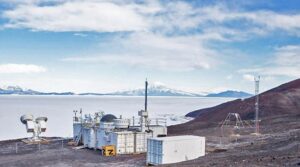 cloud and aerosol instrumentation, has a meteorological relationship with the West Antarctic Ice Sheet (WAIS) via circulation patterns in the Ross and Amundsen seas.
cloud and aerosol instrumentation, has a meteorological relationship with the West Antarctic Ice Sheet (WAIS) via circulation patterns in the Ross and Amundsen seas.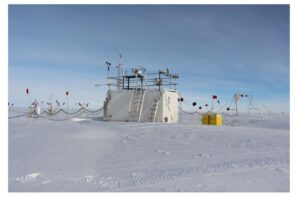
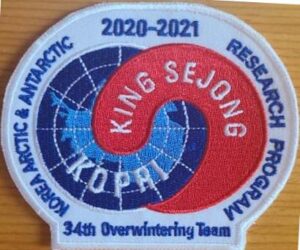 In a message just received,
In a message just received, 
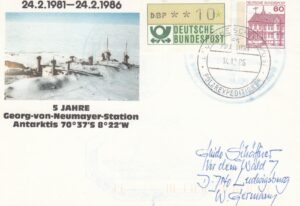

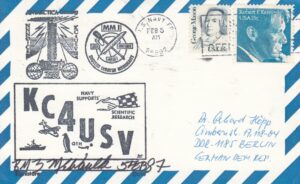
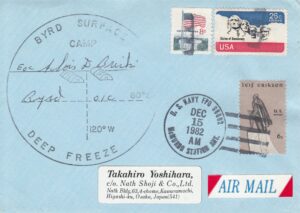
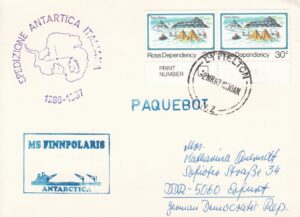 Beginners may have noticed, some cover with a handstamp of
Beginners may have noticed, some cover with a handstamp of  Korea’s Antarctic Scientific Base King Se-Jong (WAP KOR-Ø1). on King George Island, South Shetlands 62°13′ 26″ South, 58°47′ 27″ West
Korea’s Antarctic Scientific Base King Se-Jong (WAP KOR-Ø1). on King George Island, South Shetlands 62°13′ 26″ South, 58°47′ 27″ West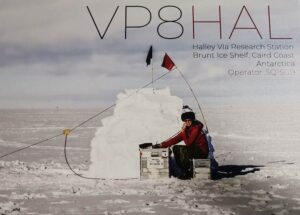 Seba SQ1SGB will sail to Halley VI(a) Base next December. He hopes to be active for 5 weeks, starting beginning of January 2021.
Seba SQ1SGB will sail to Halley VI(a) Base next December. He hopes to be active for 5 weeks, starting beginning of January 2021.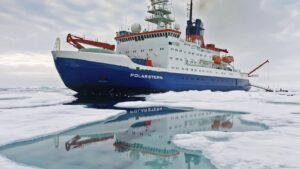 For a year the German icebreaker “Polarstern” was on a MOSAiC expedition in the Arctic to study the effects of climate change. In the early morning of October 12th, R/V Polarstern of the Alfred Wegener Institute for Polar and Marine Research is finally back in its home port of Bremerhaven.
For a year the German icebreaker “Polarstern” was on a MOSAiC expedition in the Arctic to study the effects of climate change. In the early morning of October 12th, R/V Polarstern of the Alfred Wegener Institute for Polar and Marine Research is finally back in its home port of Bremerhaven.